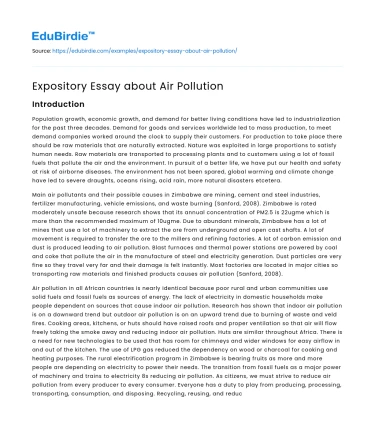Introduction
Population growth, economic growth, and demand for better living conditions have led to industrialization for the past three decades. Demand for goods and services worldwide led to mass production, to meet demand companies worked around the clock to supply their customers. For production to take place there should be raw materials that are naturally extracted. Nature was exploited in large proportions to satisfy human needs. Raw materials are transported to processing plants and to customers using a lot of fossil fuels that pollute the air and the environment. In pursuit of a better life, we have put our health and safety at risk of airborne diseases. The environment has not been spared, global warming and climate change have led to severe draughts, oceans rising, acid rain, more natural disasters etcetera.
Main air pollutants and their possible causes in Zimbabwe are mining, cement and steel industries, fertilizer manufacturing, vehicle emissions, and waste burning (Sanford, 2008). Zimbabwe is rated moderately unsafe because research shows that its annual concentration of PM2.5 is 22ugme which is more than the recommended maximum of 10ugme. Due to abundant minerals, Zimbabwe has a lot of mines that use a lot of machinery to extract the ore from underground and open cast shafts. A lot of movement is required to transfer the ore to the millers and refining factories. A lot of carbon emission and dust is produced leading to air pollution. Blast furnaces and thermal power stations are powered by coal and coke that pollute the air in the manufacture of steel and electricity generation. Dust particles are very fine so they travel very far and their damage is felt instantly. Most factories are located in major cities so transporting raw materials and finished products causes air pollution (Sanford, 2008).
Save your time!
We can take care of your essay
- Proper editing and formatting
- Free revision, title page, and bibliography
- Flexible prices and money-back guarantee
Air pollution in all African countries is nearly identical because poor rural and urban communities use solid fuels and fossil fuels as sources of energy. The lack of electricity in domestic households make people dependent on sources that cause indoor air pollution. Research has shown that indoor air pollution is on a downward trend but outdoor air pollution is on an upward trend due to burning of waste and veld fires. Cooking areas, kitchens, or huts should have raised roofs and proper ventilation so that air will flow freely taking the smoke away and reducing indoor air pollution. Huts are similar throughout Africa. There is a need for new technologies to be used that has room for chimneys and wider windows for easy airflow in and out of the kitchen. The use of LPG gas reduced the dependency on wood or charcoal for cooking and heating purposes. The rural electrification program in Zimbabwe is bearing fruits as more and more people are depending on electricity to power their needs. The transition from fossil fuels as a major power of machinery and trains to electricity 8s reducing air pollution. As citizens, we must strive to reduce air pollution from every producer to every consumer. Everyone has a duty to play from producing, processing, transporting, consumption, and disposing. Recycling, reusing, and reducing should be encouraged at all levels.
Conclusion
Air pollution is one of the types of pollution that is affecting individuals more directly than other types of pollution. Africa had 1.1 million deaths related to air pollution in 2019 (Mambondiyani, 2021). Individuals feel 'itchy eyes, nose, and throat wheezing, coughing, shortness of breath, chest pain, headaches, nausea, and upper respiratory infections' (Sanford, 2008). Research indicates that air pollution increases emphysema and asthma, the risk of cancer and cardiovascular disease and is associated with strokes and heart attacks (Sanford, 200). If air pollution is not controlled or prevented the human race is going to be wiped out clean in a few years to come. Everyone individual, organization, government, and nation should do all they can to save the future of the human race and all habitats.
References
- Mambondiyani, A. (2021), Air Pollution Killed a Million People in Africa in 2019, Eos, 102, https:doi.org10.10292021EO210565. Published on 25 October 2021.
- Sanford C. Urban Medicine: Threats to Health of Travelers to Developing World Cities. In: Jong E, Sanford C, eds. The Travel and Tropical Medicine Manual, 4th ed. Waltham: Saunders Elsevier; 2008: 18-32.
- https:www.iamat.orgcountryzimbabweriskair-pollution#:~:text=In%20accordance%20with%20the%20World,maximum%20of%2010%20%C2%B5g%2Fm3.






 Stuck on your essay?
Stuck on your essay?

